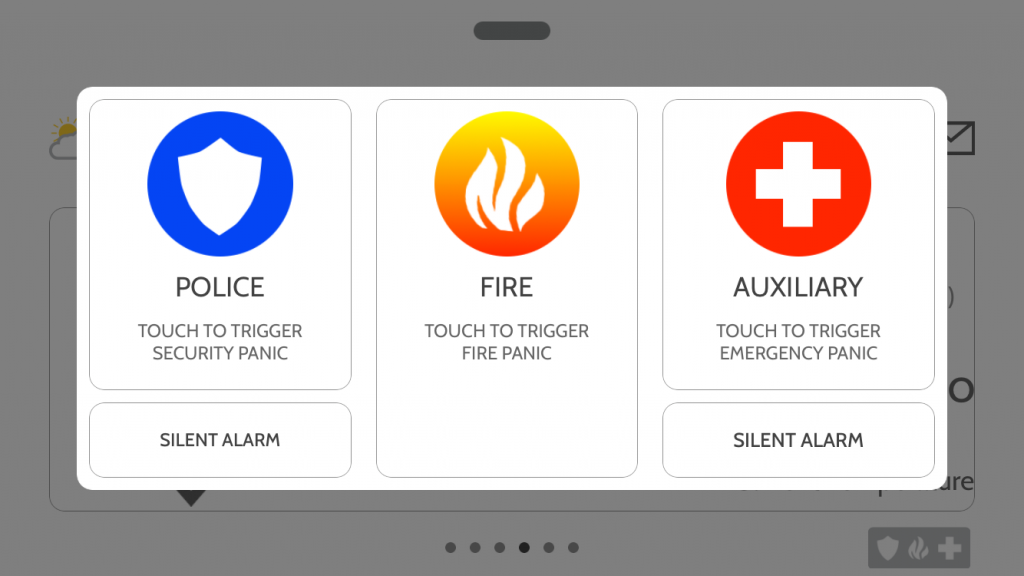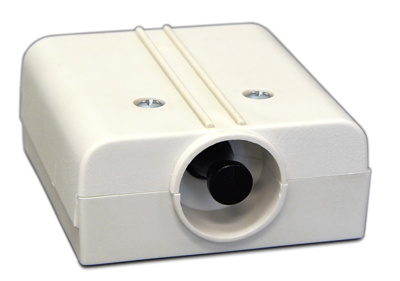Last week, we created a post on Securing Against the Unexpected. There, we detailed how we can use an alarm to secure against events above and beyond the well-known burglary and life safety-based threats that often prompt customers to install a security system. These unexpected events include such issues as weather-related damage to your property and unexpected alarm activity. However, we saved one of the most important types of security against unexpected events for today! In this post, we’ll review your panic button security options that you can add security to any burglar alarm.
First, we’ll share some residential panic button options. These will include panic buttons incorporated in the alarms panel itself. Additionally, we’ll also look at remote panic button options, including standalone panic devices as well as cellphone-based panic button security options. From there, we’ll check out some applications for commercial panic devices. These include discreet products to alert the authorities to a hold up. Furthermore, we’ll also review some options to lock down a building in the case of an emergency. Now, let’s dive in with a look at some panic button options for residential alarms!
Panic Buttons for Residential Alarms
Residential security systems are installed with a few unique concepts in mind. First, homeowners often find themselves home alone. This leads to a different set of concerns than being out and about in public. Medical situations, for example, generally receive an immediate reaction when people are around. At home, this is not the case. Homeowners also want the ability to call for immediate help if they wake up to a potential emergency situation. Let’s look at a few of the ways we use panic buttons to address some of the concerns unique to home security.
Panel-Based Panic Buttons
A security system’s keypad generally has multiple panic buttons built in. The security panels we use, such as the QOLSYS IQ Panel 4, have police, fire, and auxiliary panic buttons that allow one-touch emergency responses to multiple emergency scenarios. These functions allow for a quick and specific response to these situation. Because we generally install a keypad near the door that homeowners use to enter and exit their home, this also allows homeowners to call for help through their security system while fleeing from home. In the case of a fire, for example, a homeowner can activate the fire panic button while escaping the house. This creates a quicker response than attempting to make a 911 phone call after the fact.

The panic buttons on the IQ Panel by QOLSYS provide several different options to ensure you get the exact emergency response that you need.
Our security panel also has another built-in panic feature. In the case that a burglar creates an alarm while the homeowner is present, they will likely want the homeowner to disarm the system. We offer a “duress code” that simulates disarming the alarm system. However, even though the siren stops blaring, the system sends a silent alert to the central station. This unique panic feature creates a quick response from the police department because it is a potential hostage situation. Between the panic buttons and the duress code, your security system keypad provides several options for immediate emergency response.
Remote Panic Buttons
Wireless security systems generally allow you to use a remote to arm and disarm your system. In some cases, you can also use this remote to activate your alarm system. This means that you can carry a panic device with you at all times. You can decide whether or not activating your remote panic button activates a siren. Another type of remote panic button is a medical pendant or watch. We discussed these devices in some detail in our post showing off 6 Security Devices that Improve Senior Citizen Safety in the Home. Medical devices provide peace of mind for elderly homeowners and their families. Activating these devices does not sound an alarm. The central station will know the purpose of this alert and react accordingly. This generally involves calling an ambulance and alerting the homeowner’s family to the situation.
Phone-Based Panic Response
An interactive cellular dialer, such as our powered by Alarm.com, allows you to use your smart phone as a panic device. Just as with a remote panic device, this option allows you to have a panic button with you at all times. However, a remote requires you to be close to your security system to activate the alarm with it. A phone does not have this limitation. Also unlike a simple alarm remote, your Alarm.com phone app provides police, fire, and medical-specific panic devices at your fingertips. You can also choose between an audible alarm and a silent alarm when you activate the button. With this option, as long as you carry your smartphone, you’re never more than a few seconds away from calling for immediate help.
Panic Buttons in Commercial Applications
In public, you have much less danger of finding yourself caught alone in a dangerous situation than while at home. However, being in public brings its own set of potential emergency situations. Cash registers in stores, groups of students in classrooms, and rooms full of patients in hospitals all call for the installation of panic devices that accomplish very specific goals. In retail settings, these devices should often remain out of sight of the general public. In large school or human service-related settings, the activation of a panic button should provide certain specific information. Let’s look at some of the factors that we keep in mind when installing panic button security in these instances.
Discreet Panic Buttons
In a hold-up situation, getting to a keypad or pulling our your phone will not be practical. With this in mind, we often install panic buttons underneath counters or in other discreet locations. This allows an employee to activate the device without drawing attention. In most cases, our customers also wish for this type of panic button to not activate a siren. When violence is a possibility, remaining calm can help keep a situation under control, and the presence of a siren will not help in this regard. Upon seeing a silent panic alarm, the central station will dispatch the police without calling the premises first.

Panic buttons, such as this model by United Security Products, allow users to call for help without sounding an alarm’s siren if a silent response would create more security.
Panic Buttons for Internal Communication or Lockdown
In some settings, customers wish for the activation of a panic button to alert others on premise. In hospitals, for example, patients can use a panic button to send for immediate medical assistance. The same system can also incorporate panic buttons for employees to use to send for help. These panic buttons generally also include a tracking device to provide the location of the user. Unlike the previous options in this post, these systems do not tie into an existing security system. Instead, they have their own infrastructure that communicates with a central station. Knowing whether or not a nurse or patient needs help in a hospital, and where help is needed, is crucial in these cases.
Certain situations call for an even more drastic response than an alert sent to the front desk. In addition to sending an alert, some panic buttons can also create a lockdown situation. Schools often request these types of devices. The communication for lockdown panic buttons often relies on the internet rather than a security system or hardwired infrastructure, and the buttons themselves can be installed on a wall, desk, or even carried with teachers and staff. When activated, a lockdown panic button notifies the police, shuts down access to the building from the outside, notifies staff of any open doors, and also activates a warning played over a PA/radio system. Staff can customize what they want the actual warning to say. In addition, this action can send an automatically generated mass email. Colleges and universities, in particular, generally elect to take advantage of this option.
Putting it All Together and Creating Panic Button Security
We hope that this post helps you see how we can add panic button security to any alarm system! Moreover, we also encourage you to contact us with any questions this post may raise for you. We will happily answer any and all of your security-related inquiries. Furthermore, we also invite you to take advantage of our free site survey program. We offer complimentary security audits and equipment quotes to both new and existing customers alike. While on site, we can address your existing security concerns. Additionally, we can make suggestions based on our own observation of your property as well. Together, we can create a full security plan, complete with panic buttons, to keep your property — and everyone on it — as safe and secure as possible.
